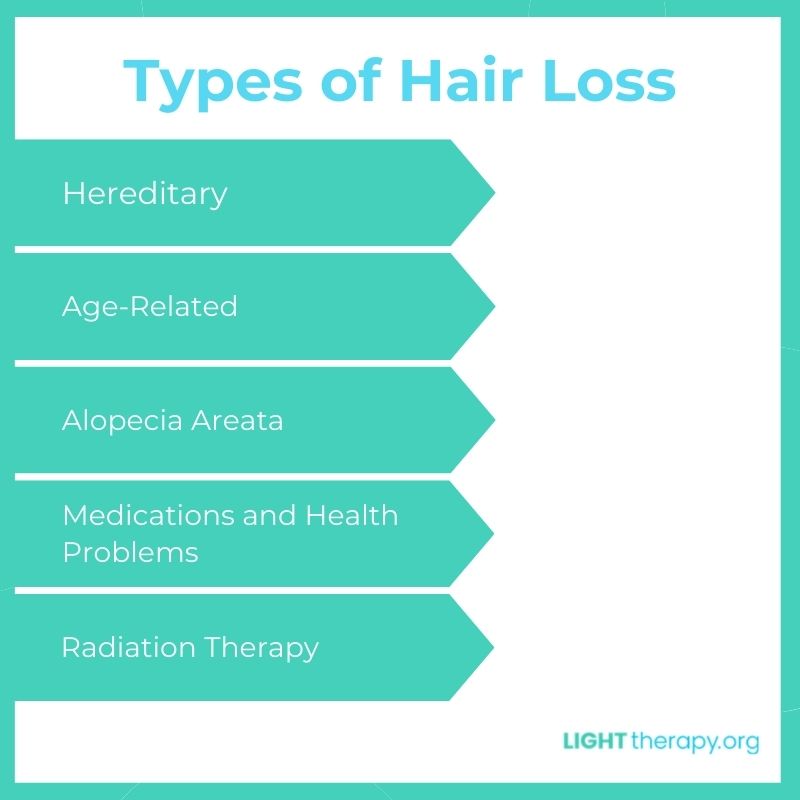What Science Says About Ultraviolet Light Therapy for Hair Loss
After all the warnings we received as kids about the danger of harmful UV (ultraviolet) rays, you’d think no good could come from exposure to ultraviolet light.
Though the spirit of our parents’ warnings was correct, UV light does have the potential for some medical benefits, such as aiding in vitamin D production.
One medical application under investigation is ultraviolet light therapy for hair loss. In this post, we’ll look at what light therapy is, how hair loss happens, and whether ultraviolet light therapy for hair loss holds any promise.
What Is Light Therapy?
The electromagnetic spectrum’s visible light can be isolated into different colors and wavelengths, each with their own properties. Light therapy is a treatment that uses these specific colors and wavelengths of light to produce beneficial effects in the human body.
The unit of measurement for light wavelengths is nanometers (nm). The visible wavelengths of light include:
- Violet light (380-450 nm)
- Blue light (450-495 nm)
- Green light (495-570 nm)
- Yellow light (570-590 nm)
- Orange light (590-620 nm)
- Red light (620-750 nm)
Some types of light, like infrared and ultraviolet light, are outside the visible spectrum and undetectable to the human eye. Ultraviolet light wavelengths fall between 10 nm and 400 nm.
So how can light affect human health? Some light wavelengths disinfect surfaces, some improve wakefulness, and some absorb into our mitochondria for the production of adenosine triphosphate (ATP), our cells’ main source of energy.
What Is Hair Loss and How Does It Happen?
We’re all losing hair all the time — 100 strands per day on average! It’s why we find hair in the shower drain and on the floor. But clinical hair loss is much more pronounced. Sufferers lose far more hair and can’t regrow enough to replace what falls out.
Below are a few of the main types of hair loss.

Hereditary Hair Loss
Hereditary hair loss, also known as hereditary alopecia, develops when the hair follicles become overly sensitive to dihydrotestosterone (DHT), a hormone. Exposure to DHT weakens the follicles, deteriorating them and making them unable to produce new hair.
Hereditary hair loss is often responsible for hair thinning and receding hairlines as a person gets older. It’s especially prevalent in men, who may begin losing hair as early as their 20s.
You may have heard hereditary alopecia referred to as male-pattern baldness or female-pattern baldness. Female-pattern baldness tends to cause a general thinning of all the hair on the head, although this loss may be especially noticeable around the crown. Male-pattern baldness tends to cause the hairline to creep backward at the forehead and temples, and then a bald spot forms on the crown of the head.
Age-Related Hair Loss
Hereditary alopecia may correlate with age, but it is passed down from parent to child. Age-related hair loss has to do with biological changes taking place as a result of growing older.
Many women begin to experience more intense hair loss after menopause. The significant reduction in a woman’s estrogen levels leads to thinner hair that breaks more easily.
Hair follicles also stop producing hair as quickly in older adults, and new hair growth can no longer keep up with a normal rate of hair loss.
Alopecia Areata
Alopecia areata is an autoimmune condition in which the body attacks its own hair follicles. It results in small, patchy bald spots distributed over the surface of the scalp. Nearly seven million Americans suffer from alopecia areata.
Medications and Health Problems
Medications come with side effects, one of which can be hair loss. Certain medications for depression, heart disease, high blood pressure, and arthritis are all known to trigger hair loss. Perhaps the most widely recognized medications that cause alopecia are chemotherapy drugs for cancer treatment.
A variety of medical problems can also trigger hair loss and negatively affect regrowth, including autoimmune diseases, scalp infections, and thyroid disease.
Radiation Therapy
Many cancer patients receive radiation therapy in addition to chemotherapy, but this process also kills healthy cells, including hair cells. Because hair cells grow so rapidly compared to other body cells, they are at the highest risk of destruction from the intense levels of radiation needed for cancer treatment.
Is Ultraviolet Light Therapy Helpful for Hair Loss?
Hair loss can be a difficult and emotionally taxing ordeal. As such, it’s encouraging that different forms of light therapy are being explored to treat this ailment. As with any new therapy, though, we first want to make sure it’s safe, and then that it’s effective.
So can ultraviolet light therapy decrease hair loss or increase hair growth? Let’s take a look at the evidence.
One 2011 retrospective study examined 25 alopecia areata patients treated with a targeted type of ultraviolet light therapy. Researchers concluded that this type of ultraviolet light therapy was not effective for hair loss from alopecia areata. Only 20% of the light-treated patients saw excellent responses, most of whom were also receiving treatment with corticosteroids.
Several reputable, nationally recognized hair loss clinics say suggest avoiding ultraviolet light therapy for hair loss because of its risks and poor results. Others state that ultraviolet light therapy may have some benefit, but that it’s likely limited to people with very mild hair loss.
In some of our posts, we link to relevant products and services that are available. However, we’re unable to recommend any ultraviolet light therapy services for hair loss here, since evidence does not support their efficacy, and they carry the possibility of side effects such as skin discoloration and increased cancer risk.
Ultraviolet Light Therapy for Hair Loss: Not a Promising Outlook
Most studies available on ultraviolet therapy and hair loss center around alopecia areata, and the results aren’t promising. Other treatments with light, such as red light therapy, offer a more optimistic outlook and certainly a better safety profile.